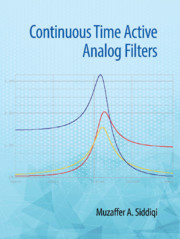Book contents
- Frontmatter
- Dedication
- Contents
- Preface
- Acknowledgments
- 1 Analog Filter: Concepts
- 2 First-and Second-order Filters
- 3 Magnitude Approximations
- 4 Delay: Approximation and Optimization
- 5 Frequency and Impedance Transformations
- 6 Sensitivity of Active Networks
- 7 Single Amplifier Second-order Filters
- 8 Multi Amplifier Second-order Filter Sections
- 9 Direct Form Synthesis: Element Substitution and Operational Simulation
- 10 Cascade Approach: Optimization and Tuning
- 11 Amplification and Filtering in Biomedical Applications
- 12 Audio Signal Processing and Anti-aliasing Filters
- 13 Follow the Leader Feedback Filters
- 14 Switched Capacitor Circuits
- 15 Operational Transconductance Amplifier-C Filters
- 16 Current Conveyors and CDTA (Current Differencing Transconductance Amplifiers) Based Filters
- 17 Active R and Active C Filters
- Index
4 - Delay: Approximation and Optimization
Published online by Cambridge University Press: 24 December 2019
- Frontmatter
- Dedication
- Contents
- Preface
- Acknowledgments
- 1 Analog Filter: Concepts
- 2 First-and Second-order Filters
- 3 Magnitude Approximations
- 4 Delay: Approximation and Optimization
- 5 Frequency and Impedance Transformations
- 6 Sensitivity of Active Networks
- 7 Single Amplifier Second-order Filters
- 8 Multi Amplifier Second-order Filter Sections
- 9 Direct Form Synthesis: Element Substitution and Operational Simulation
- 10 Cascade Approach: Optimization and Tuning
- 11 Amplification and Filtering in Biomedical Applications
- 12 Audio Signal Processing and Anti-aliasing Filters
- 13 Follow the Leader Feedback Filters
- 14 Switched Capacitor Circuits
- 15 Operational Transconductance Amplifier-C Filters
- 16 Current Conveyors and CDTA (Current Differencing Transconductance Amplifiers) Based Filters
- 17 Active R and Active C Filters
- Index
Summary
Introduction
While studying magnitude approximations in Chapter 3, real rational functions were selected in order to achieve desirable attenuation in the stop band and pass band. Not much attention was paid on the unintentional occurrence of phase shift or delay. It has been observed that this delay is neither the same for different approximations nor is it constant. In fact, filter delay is highly dependent on the type of approximation, order of the filter and its parameters. As an example, normalized delay for a fourth-order maximally flat, Chebyshev, inverse Chebyshev and Cauer or elliptic filter, with equal order of pass band attenuation in each case, is shown in Figure 4.1. It can be observed that the delay performance in the maximally flat case is the closest to the ideal requirement of constant delay with frequency. Performance is the worst for the elliptic filter and intermediate for the Chebyshev and the inverse Chebyshev cases. It is important to note that though Figure 4.1 is only a representative sketch, the nature of the functions remain the same: maxima of the delay occur near the pass band edge and relative maxima are dependent on filter specifications in the pass and stop bands.
It is important to have the group delay as constant or the phase response of the filter as linear with frequency. This requirement for filters is necessary in order to process the magnitude and because in many applications, the amount of delay needs to be controlled at the same time. For example, in a telephonic conversation through satellite, generally, the communication channel is active one way and the listener speaks only when the speaker from the other side stops. However, if the delay is too large, two-way conversation will become difficult and sometimes overlapping.
From this brief discussion, it is clear that in order to avoid distortion due to different phase/group delay in a filter, an ideal transfer function should have its delay constant with frequency.
In Section 4.2, delay is defined. Its relation with the phase change in a filter section and the normalized transfer function of a filter realizing delay are also discussed in detail.
Information
- Type
- Chapter
- Information
- Continuous Time Active Analog Filters , pp. 101 - 124Publisher: Cambridge University PressPrint publication year: 2020
